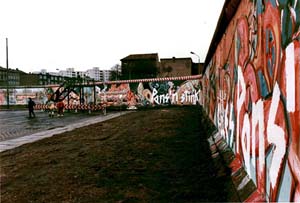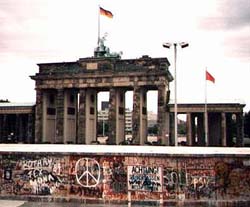Course home
page
Assignment
What was the impact of the destruction of the Berlin Wall on East-West relations and the Cold War?
Background
Since 1961, the Berlin Wall had been the symbol
of the Cold War and the division of Germany and Europe into East and West.
In the late 1980s, however, the situation changed dramatically.
Change began in the Soviet Union when Mikhail Gorbachev became the
new head of the communist party in 1986. He initiated new policies
of perestroika (reorganizing the economy) and glasnost' (openness).
Quickly the winds of reform blew into Eastern
Europe, and the situation of the communist regime deteriorated in East Germany.
During the summer of 1989, there were mass escapes (via Hungary) fromthe
country and mass demonstrations in Leipzig, Berlin and other cities. Just
as the GDR prepared to celebrate its fortieth anniversary, on 18 October,
the hard-line communist government of Erich Honecker resigned. On 9
November the new East German government opened its country's borders with
West Germany (including West Berlin). By 11 November, the wall had
ceased to function.
The opening of the wall brought the almost
thirty-year division of Berlin to an end, and the subsequent reunification
(October 1990) of Germany ended the forty-five-year occupation of the city.
With a few segments preserved as a monument, the wall has been completely
removed. During its existence, about five thousand East Germans had
managed to cross the Wall (by various means) and reach the West safely,
while another five thousand had been captured by East German. Almost
two hundred more died during attempts to cross the wall.
Timeline
1948, June: Berlin airlift began.
1949, May: Berlin airlift ended.
1961, 13 August: Berlin Wall erected.
 1989, 15 January; Demonstrators in Leipzig
call for freedom of speech.
1989, 1 September: An increasing number
of East Germans began to flee to West.
1989, 11 September: Hungary opened its
border to West; 15,000 East Germans escape via Hungary and Austria.
1989, 19 September: The democratic "New
Forum" alliance founded in East Germany.
1989, 18 October: Erich Honecker
resigned.
1989, 9 November: Egon Krenz and the SED
government announced at a press conference that restrictions on travel abroad
for East Germans had been lifted.
1989, 10 November: Almost two million
East Germans enter West after lifting of restrictions.
1989, 11 November: Berlin Wall ceased
to exist as a barrier.
1989, 28 November: Chancellor Kohl announced
plan for german unity.
1990, 18 March: free elections held in
East Germany.
1990, 3 October: Germany re-united.
1989, 15 January; Demonstrators in Leipzig
call for freedom of speech.
1989, 1 September: An increasing number
of East Germans began to flee to West.
1989, 11 September: Hungary opened its
border to West; 15,000 East Germans escape via Hungary and Austria.
1989, 19 September: The democratic "New
Forum" alliance founded in East Germany.
1989, 18 October: Erich Honecker
resigned.
1989, 9 November: Egon Krenz and the SED
government announced at a press conference that restrictions on travel abroad
for East Germans had been lifted.
1989, 10 November: Almost two million
East Germans enter West after lifting of restrictions.
1989, 11 November: Berlin Wall ceased
to exist as a barrier.
1989, 28 November: Chancellor Kohl announced
plan for german unity.
1990, 18 March: free elections held in
East Germany.
1990, 3 October: Germany re-united.
WWW sites
There are quite a few sites devoted to the
Wall.
-
Berlin
Wall, a personal view of Berlin and the effect of the Berlin wall on
the city and its inhabitants by Chris De Witt (contains photographs).
-
The
Berlin Wall
(auf Deutsch and in English) contains info on the Background, Construction,
Measurements and Fall of the Wall.
-
There is a short history of the city of
Berlin.
-
The
Berlin Wall
is a short history of significant events concerning the Berlin Wall from
its construction in August 1961 to its fall in November 1989, including a
list of related links and photos.
-
There is a
Fall
of the Berlin Wall with a short chronology page.
-
Die
Mauer-seite (auf Deutsch) includes both Mauerbau and Mauerfall
projects.
-
A
Photo Exhibition of the Berlin
Wall is straight-forward.
-
A
Chronicle
of unification.
-
On 9 November 1997 a
CNN story described
the German celebration of the anniversary of the Wall.
Some scattered sources include:
The
Letter From Chairman
Khrushchev to President Kennedy on a German Peace Treaty, September 29,
1961.
Die Rede des Präsidenten John F.Kennedy
vor dem Rathaus Schöneberg, Berlin Wall speech,
Ich
bin ein Berliner," 26 June 1963; (German translation & English
recording).
The John F. Kennedy
Speech at the Berlin
Wall, 1963 (part of an exhibition at the Library of Congress [WAV
(297K)].
You can also
order pieces of the
Wall. There are several such sites.
Still more:
Recommended Books
Books devoted specifically to the Wall include:
-
John Marks, The Wall (1998)
-
Katie Hafner, The House at the Bridge: A Story
of Modern Germany (1995)
-
James McAdams, Germany Divided: From the Wall
to Reunification (Princeton, 1993)
-
Gale Stokes, The Walls Came Tumbling Down (New
York: Oxford University Press, 1992)
-
Doris Epler, The Berlin Wall: How It Rose and
Why It Fell (1992)
-
Leland Rice, Photographs of the Berlin Wall
(1991)
-
Jerry Bornstein, The Wall Came Tumbling Down (New
York, 1990)
-
Peter Wyden, WALL: The Inside Story of Divided
Berlin (New York: Simon and Schuster, 1989)
-
John Delman, Flashpoint: The Division of Berlin
(Vero Beach, 1988)
-
Norman Gelb, The Berlin Wall: Kennedy, Khrushchev
and a Showdown in the Heart of Europe (New York, 1986) [THE
BEST]
Some interesting articles include:
-
William Ellis, "The Morning After: Germany Reunited,"
National Geographic, September 1991, pp. 2-41.
-
"The Boy Who Died On The Wall," Life Magazine,
August 1962, pp. 16-22.
-
Don Cook, "Digging a Way to Freedom," The Saturday
Evening Post, 1 December 1962, pp. 30-37.
-
"The Other Side Of The Wall," The New York Times
Magazine, 8 October 1961, pp. 4-5.
Related Events
Berlin Air Lift
Germany 1945
Germany 1990
Berlin Wall 1961
|

